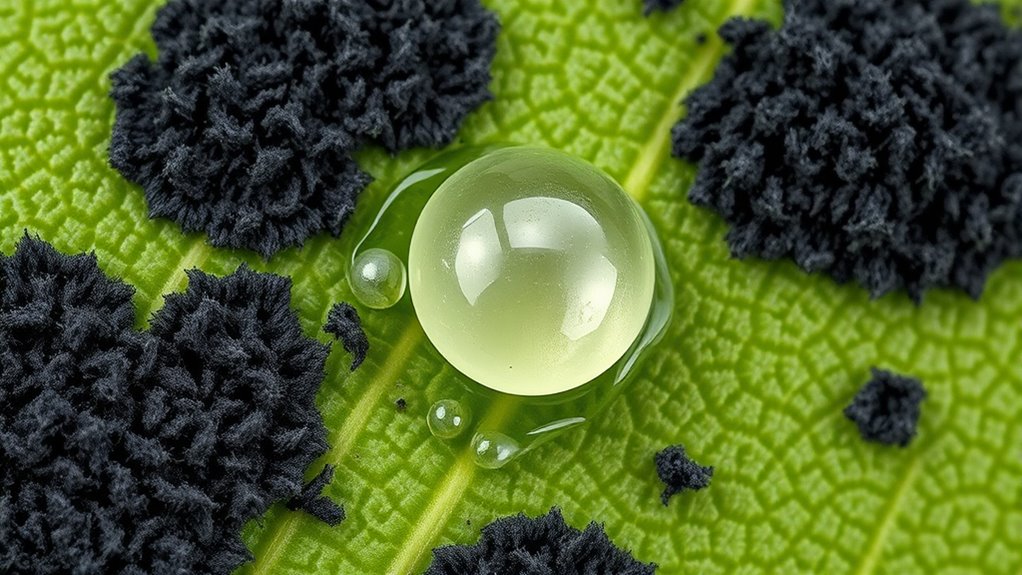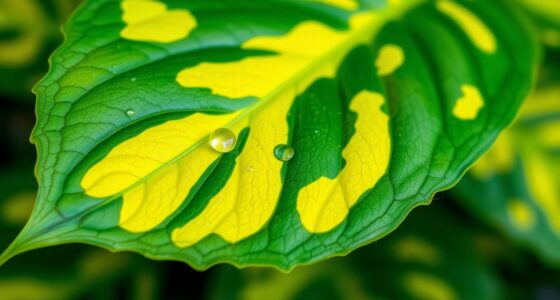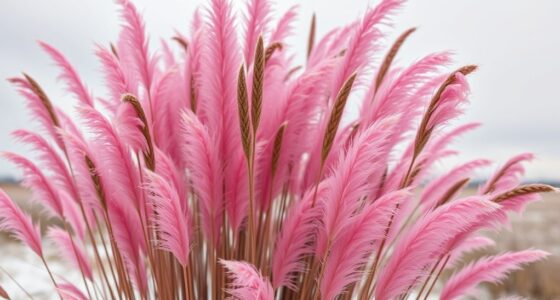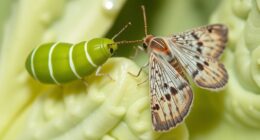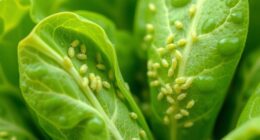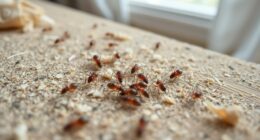Linden tree droppings often include sticky honeydew, which appears as a shiny, greasy coating on leaves or branches, and can cause black sooty mold to develop. Honeydew is produced by insects like aphids or scales and looks different from dust or natural resin. Sooty mold grows on this residue, forming a dark coating that hampers photosynthesis. To understand how to identify and manage these issues, keep exploring the signs your tree shows.
Key Takeaways
- Honeydew appears as sticky, shiny residue on linden leaves and branches, often accompanied by black sooty mold.
- Sooty mold is a black, powdery fungus that grows on honeydew-covered surfaces, impairing photosynthesis.
- Droppings from aphids and scale insects produce honeydew, distinguishable from dust, dirt, or plant exudates.
- Early signs include leaf discoloration, curling, reduced flowering, and black coating on foliage.
- Regular inspection and pest control help prevent honeydew buildup and sooty mold development.
Recognizing the Appearance of Honeydew on Linden Trees
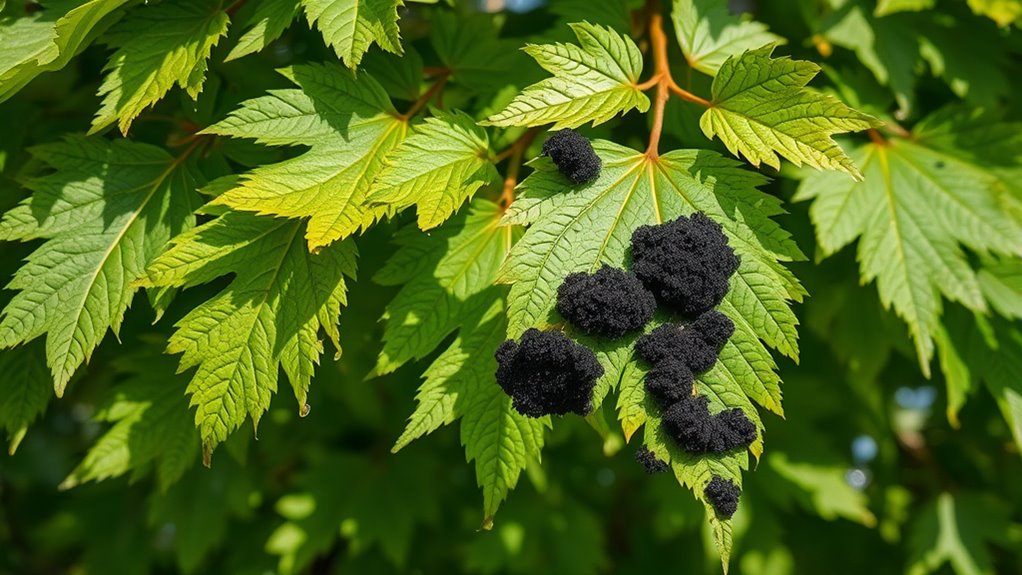
Have you ever noticed a sticky, shiny coating on the leaves or branches of your linden tree? That’s a sign of honeydew, a sweet, sticky substance secreted by sap-sucking insects like aphids or scale insects. You might also observe changes in flowering patterns, such as fewer blossoms or irregular flowering times, which often accompany honeydew presence. Leaf discoloration is another clue; leaves may turn yellow, curl, or develop black sooty mold, indicating that honeydew is encouraging mold growth. These symptoms usually appear during warm, humid weather when insects are most active. Recognizing these signs early helps you understand that your linden tree is affected by insect activity and honeydew buildup, prompting you to monitor for further issues. Additionally, high contrast ratio in your observation can help you better see the subtle changes on the leaves and branches, making it easier to detect early signs of infestation. Being aware of insect activity that causes honeydew can also assist in planning effective management strategies. Recognizing the symptoms of mold growth can help prevent further damage to your tree.
Differentiating Honeydew From Other Tree Residues
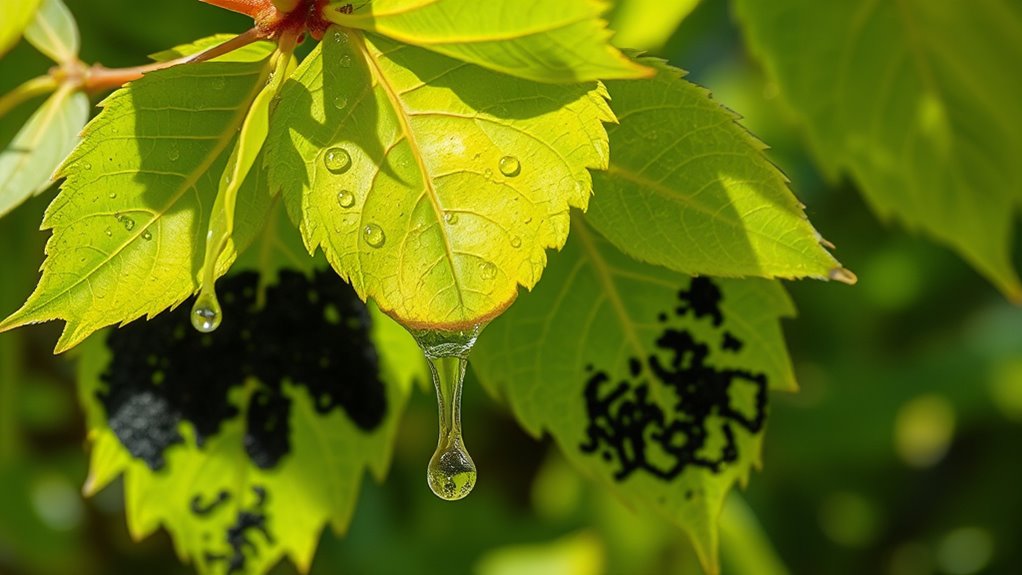
To accurately identify honeydew on your linden tree, you need to distinguish it from residues like dust, dirt, or natural plant exudates. Honeydew is sticky and often caused by insect infestation, such as aphids or scale insects, which feed on tree sap. Unlike dust or dirt, honeydew feels greasy and can be easily wiped away. Natural plant exudates typically have a different texture and appearance. Here’s a visual comparison:
| Residue Type | Texture | Key Indicator |
|---|---|---|
| Honeydew | Sticky, greasy | Caused by insect feeding |
| Dust/Dirt | Dry, powdery | Non-sticky |
| Plant Exudates | Thick, resinous | Usually clear or amber |
| Sooty Mold | Powdery, black | Grows on honeydew |
Additionally, vibrational energy can influence how your tree responds to pest infestations, which may help prevent or reduce honeydew accumulation.
What Is Sooty Mold and How Does It Develop?
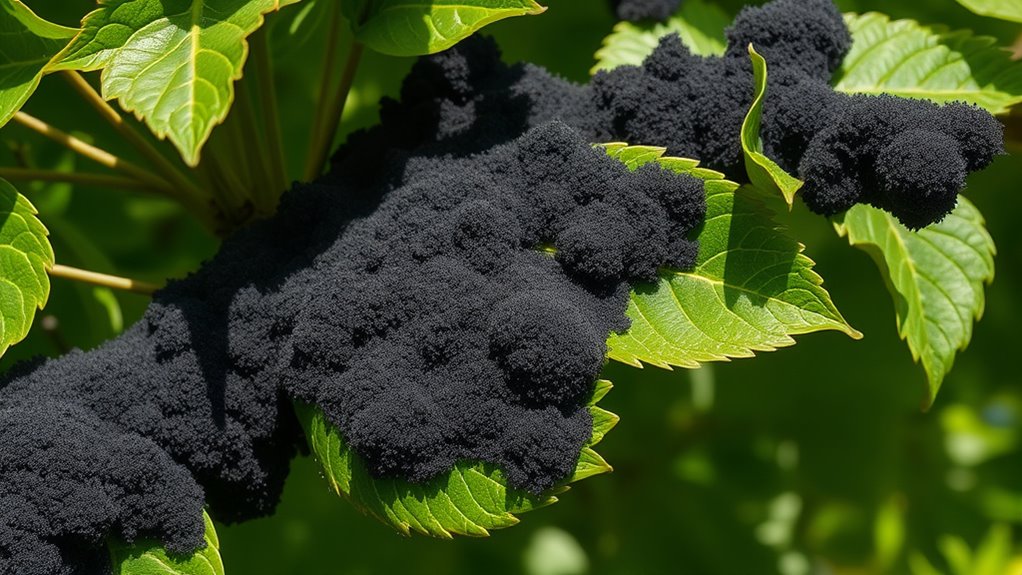
Sooty mold is a black, powdery fungus that grows on plant surfaces, especially where honeydew has accumulated. It thrives on the sticky substance produced when insects, like aphids or scale insects, infest a tree. These insects feed on tree sap, causing it to excrete excess honeydew. When this sweet, sticky residue isn’t cleaned away, it provides an ideal environment for sooty mold to develop. The mold appears as a dark, soot-like coating on leaves, branches, and trunks. Its growth depends on the presence of honeydew and the insect infestation that produces it. Utilizing vertical storage solutions can help manage fallen leaves and debris around trees, reducing the chances of mold development. Sooty mold doesn’t directly harm the tree’s roots or vascular system, but it can block sunlight, impair photosynthesis, and make the tree look unhealthy. Maintaining proper pest management can prevent the buildup of honeydew and subsequent mold growth.
The Impact of Honeydew and Sooty Mold on Tree Health
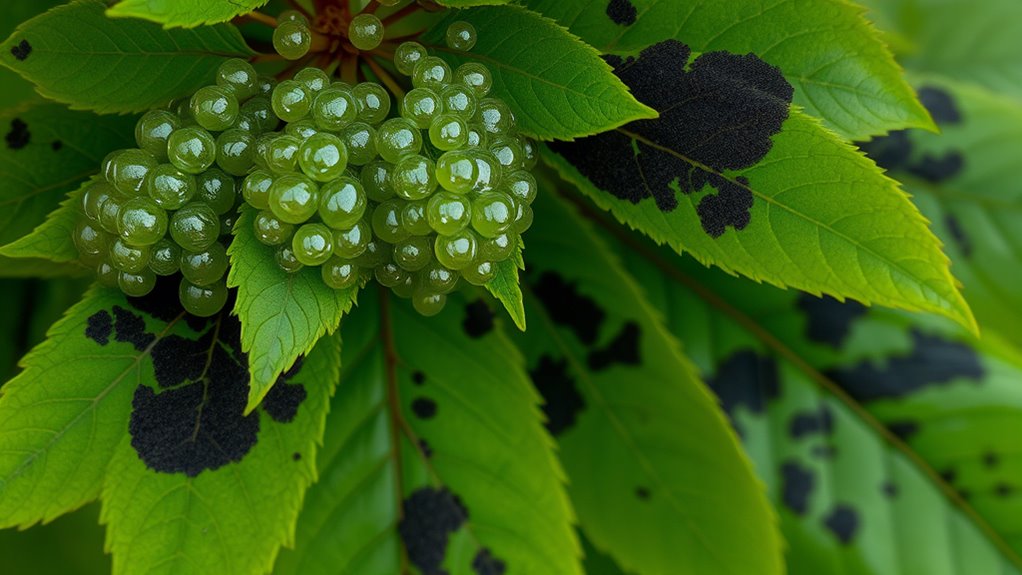
Honeydew and sooty mold can considerably affect a tree’s health by blocking sunlight and hindering photosynthesis. When pests like aphids or scale insects produce honeydew, it creates a sticky layer on the leaves, which encourages sooty mold growth. This cover reduces light absorption, weakening the tree’s ability to generate energy. Over time, persistent infestations can lead to nutrient deficiencies because the pests extract essential nutrients from the tree, further compromising its vitality. The combined effect of honeydew and sooty mold can slow growth, cause leaf drop, and make trees more vulnerable to stress and disease. If left unmanaged, these issues can weaken the overall health of your tree, making it more susceptible to additional pest problems and environmental stressors.
Effective Strategies for Managing Honeydew and Sooty Mold
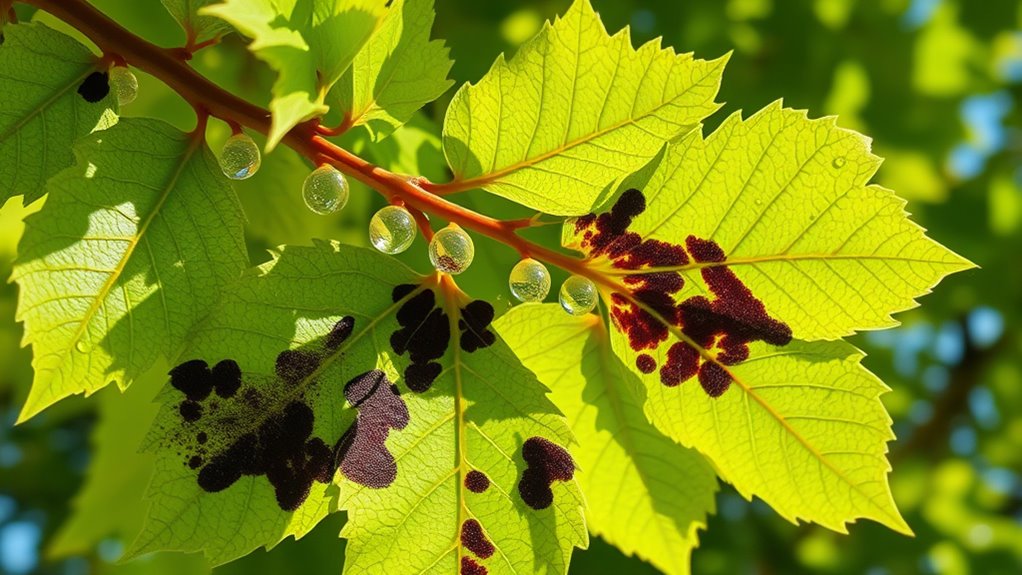
Effective management of honeydew and sooty mold begins with regular inspection and prompt action. You should monitor your trees frequently for signs of pest activity, especially aphids or scale insects, which produce honeydew. Implement pest control methods such as insecticidal soap or horticultural oils to reduce pest populations and prevent honeydew buildup. Proper fertilizer application can also strengthen the tree’s defenses, making it less susceptible to infestations. Avoid over-fertilizing, as excess nutrients can encourage pest growth. Pruning affected branches helps improve air circulation and reduces mold spread. Regularly inspecting for pest activity is crucial, as early detection can significantly minimize damage. Staying vigilant for early signs of infestation allows for timely intervention and better management outcomes. Additionally, understanding the specific pests responsible for honeydew production can help tailor more effective treatment strategies. Combining these strategies ensures you tackle the root causes of honeydew and sooty mold, keeping your trees healthier and minimizing the need for extensive chemical treatments.
Preventative Measures to Minimize Droppings and Mold Growth
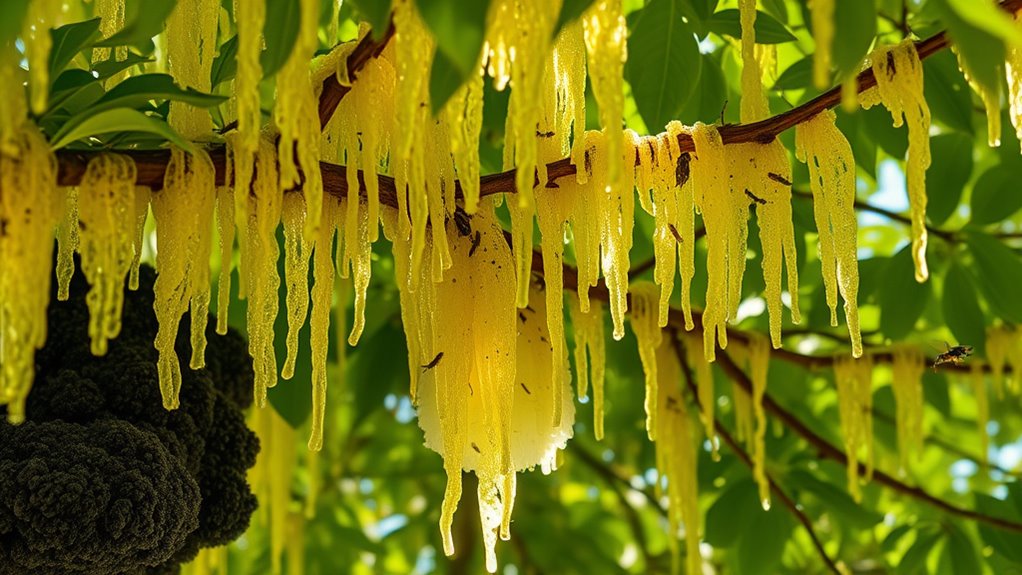
Regular monitoring and prompt pest management are key to preventing the buildup of droppings and mold on your trees. Implementing proper pruning practices helps improve air circulation and reduces the chances of mold growth, while removing dead or infected branches minimizes pest habitats. Consider using chemical treatments, such as insecticides, to control sap-sucking pests like aphids and scale insects that produce honeydew. Applying these treatments early can prevent pest populations from thriving and depositing droppings on the foliage. Regularly inspect your trees for signs of pest activity and mold buildup, acting quickly to address issues before they escalate. Combining vigilant monitoring with targeted pruning and chemical treatments helps keep your linden trees healthy and free of excessive droppings and mold. Additionally, understanding the types of pests that produce honeydew can help you select the most effective control methods. Recognizing the signs of infestation early allows for more effective intervention and minimizes damage to your trees.
Frequently Asked Questions
Can Honeydew Attract Harmful Insects to Linden Trees?
Yes, honeydew can attract harmful insects to your linden tree. Honeydew insects, like aphids and scale, feed on the sap and produce this sticky substance. When honeydew accumulates, it creates a sweet environment that pest insects find appealing, leading to increased pest attraction. This can cause further damage to your tree, so it’s important to manage honeydew buildup and monitor for pest activity to protect your linden.
Are There Natural Ways to Control Sooty Mold Growth?
Did you know that over 80% of gardeners prefer natural remedies for pest control? To control sooty mold naturally, try rinsing the affected leaves with a strong jet of water to remove the mold and honeydew. You can also apply botanical fungicides or a mixture of water and a small amount of dish soap. These eco-friendly options help suppress mold growth without harmful chemicals, keeping your trees healthy and vibrant.
How Long Does Honeydew Typically Stay on the Tree Surface?
You might wonder about honeydew duration and how long it stays on the tree surface. Typically, honeydew persists for a few weeks, especially if weather conditions are humid or rainy. It can be washed away naturally by rain or cleaned off with water, but if left, it can lead to sooty mold growth. Regular monitoring helps you manage its tree surface persistence effectively and keep your tree healthy.
Does Honeydew or Mold Affect Fruit Production in Linden Trees?
You might think honeydew and mold are just messy nuisances, but surprisingly, they can actually impact your tree’s fruit yield and overall health. Honeydew can promote sooty mold, which blocks sunlight and hampers photosynthesis. This stress weakens the tree, potentially reducing fruit production and making it more vulnerable to disease. So, while they look harmless, ignoring these issues can lead to a less fruitful and less healthy tree.
Are Some Linden Tree Varieties More Prone to Honeydew and Mold?
Some Linden tree varieties are more prone to honeydew susceptibility than others. You’ll notice that certain varieties, like the American Linden, tend to produce more honeydew and develop sooty mold more often. If you want to reduce these issues, choose resistant varieties and guarantee proper tree maintenance. Regular pruning, watering, and pest control can help minimize honeydew buildup and prevent mold from affecting your Linden trees’ health.
Conclusion
By mastering the methods to monitor and manage honeydew and sooty mold, you can protect your trees and promote vibrant vitality. Recognize the residues, react promptly, and implement preventative practices to prevent persistent problems. Taking proactive steps not only preserves your trees’ health but also keeps your landscape lush and lovely. So, stay vigilant, act promptly, and guarantee your Linden trees flourish free from fungal flaws and sticky surprises.
